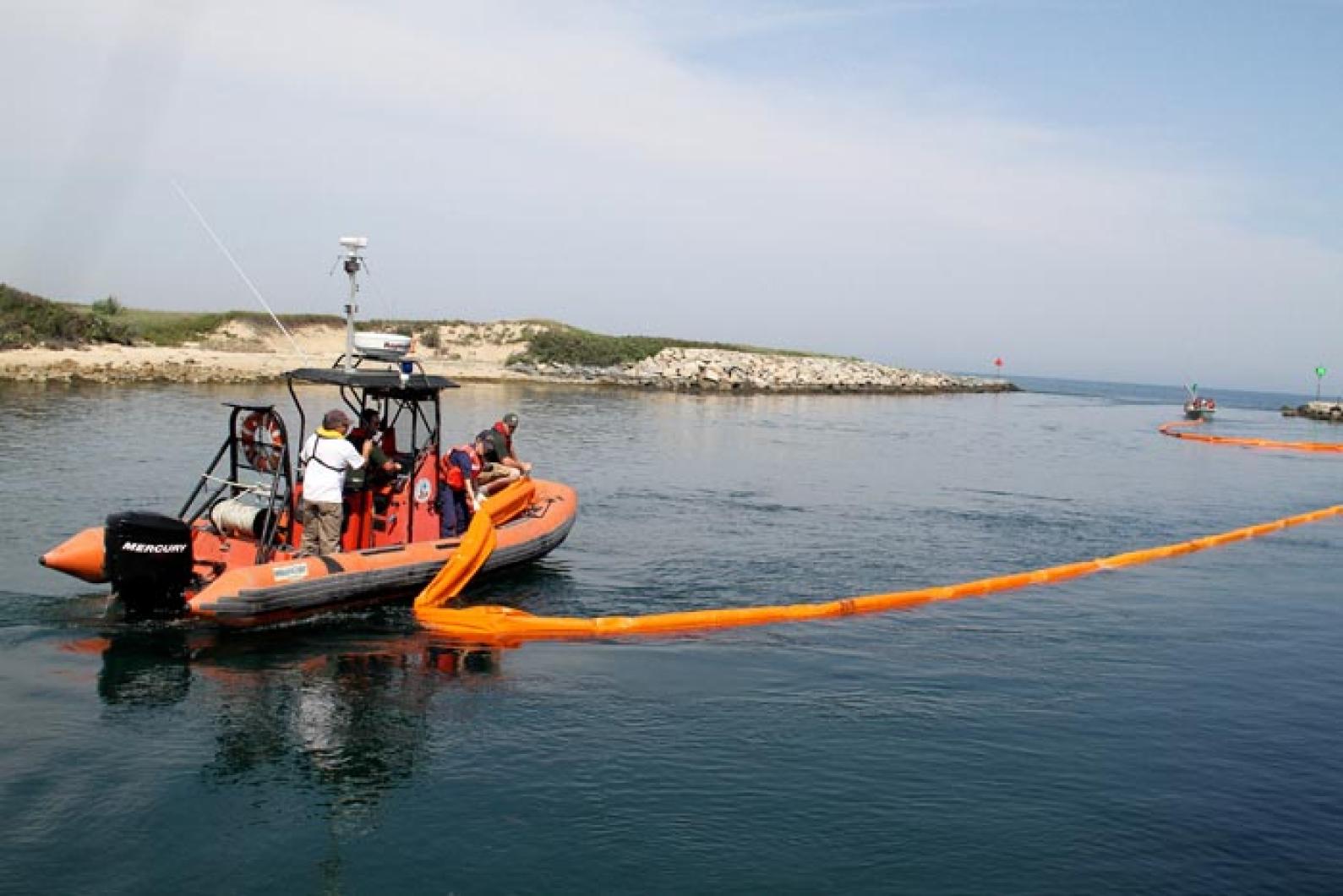It was a perfect day to be on the water last Wednesday in Menemsha; there was little wind and the sun was shining as the commercial and recreational harbor began to get under way for the summer season. But what if one of those boats had an accident and oil began to cascade into the inner harbor, or worse, if a large tanker had an incident out in Buzzards Bay?
With both scenarios real possibilities, Islanders prepared an emergency response plan in the event of an oil spill.
Officials from the Massachusetts Department of Environmental Protection, several Coast Guard stations in the area, Chilmark, Aquinnah and the Wampanoag Tribe of Gay Head (Aquinnah) were on the water all day learning how to use oil spill booms and determining the best course of action given one very large obstacle — the current.
“It’s really shocking how hard it is to get around the current, the water is just going right over [the booms],” said Bret Stearns, director of natural resources for the tribe, standing at the Menemsha Texaco dock between drills. “The flow of this harbor has changed significantly. From being out here and experiencing it, it feels very different.”
The new flow of the current came with the new town dock, rebuilt after it was destroyed in the July 12 Coast Guard boathouse fire last year.
“The way the water moves feels different, the way the boat holds to the shore feels different,” Mr. Stearns said. “So it’s great to get out here and try it, I was really surprised.”
Training was led by Nuka Research, with some instruction by spill response experts from Moran Environmental and the coast guard. The tribe received a grant from the Environmental Protection Agency to hold the training.
“The whole purpose of this is to get practical, hands-on experience,” Nuka Research coordinator Elise DeCola said. “We came in here knowing that that tactic had a chance of failing, and I think everyone who was out in the water discovered it was really not feasible to do.
“The worst thing is to have plan on paper that creates confidence about something you really can’t do,” she said.
Response scenarios tested included a vessel leaking 4,000 gallons of fuel (most commercial boats carry 1,500 gallons at most) to smaller spills in the West Basin.
If a larger spill were to occur off the coast of the Vineyard, Mr. Stearns said the towns would have to hire a subcontractor to bring in special booms equipped to handle such a large spillage.
For Menemsha Pond, the greatest challenge is making sure the oil would not get into the wetlands and surrounding bodies of water, namely Squibnocket, Nashaquitsa and Stonewall Ponds and Edys Island. The booms set up in the harbor would stop the oil from spreading and divert the oil to beaches for easier cleanup.
But trial and error was the theme of the day, and Mr. Stearns said it was better to learn what didn’t work before anything really happened.
“We’re here to figure out realistic scenarios,” he said. “It’s really disappointing, it looks like it would have worked.”
Back on the boat for another shot at devising a workable plan, the team grew frustrated as they fought the current and pried the orange booms caught on private moorings. A land team stood by on the beach with a tractor full of booms that unfolded from the storage unit like a large intestine as three boats towed the booms around the harbor.
Suggestions shot around:
“What if we started at Edys Island and worked our way back up?”
“What if we tied to one of the private pilings?”
“We need to come at it at a different angle.”
“I think it’s time for a new plan,” Mr. Stearns conceded, radioing over to Chilmark shellfish constable Isaiah Scheffer, “The oystercatchers are starting to laugh at us.”
A group of them flew over the boat, cackling.
But in the end a successful plan was devised.
“What we came to realize is that by using what we have, with most likely limited amount of people at the time of an event, we can successfully protect the back side of Edys Island and West Basin, which is extremely important, and we can block off Nashaquitsa Pond and Squibnocket Pond. We can quickly and efficiently protect 1,000 acres,” Mr. Stearns said the next morning, reflecting on the previous day’s drills.
“In the event of a spill we now know one of the first things we need to do is initiate the harbormasters to get boats out of harbor area, simply tow them and put them in a sheltered area and then put down the boom,” he continued. “That was the most important step to realize. We need to do that before we do anything. We can then use the mooring field as anchor points, tie the boom right to moorings, and use that area as part of our toolbox instead of something we could go around.”
It was a good learning experience, Mr. Stearns concluded.








Comments
Comment policy »